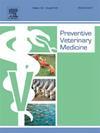加拿大魁省的小牛肉管理:第二部分。到达时被动免疫转移与平均日增重的关系
IF 2.2
2区 农林科学
Q1 VETERINARY SCIENCES
引用次数: 0
摘要
小牛肉犊牛的平均日增重(ADG)是一个重要的结果,以监测小牛肉生产商最大限度地提高利润。被动免疫转移(TPI)对奶牛和肉牛至关重要。关于曲海地区小牛肉TPI与平均日增重之间关系的研究资料很少。本研究的目的是调查与曲海地区牛奶和谷物喂养小牛肉犊牛平均日增重降低相关的到达危险因素的影响。在2017年10月至2018年12月期间,对加拿大quizembec不同地理位置的59批次牛奶和谷物喂养的小牛肉进行了一项前瞻性队列研究(n = 1729头小牛)。到达后,每批随机抽取30头小牛,使用Brix折光计(血清阈值<;8.4% (TPI不足)。在整个生产周期中,提取每批小牛的所有健康记录,并用于量化个体和群体层面的风险因素。在使用有向无环图绘制因果图后,ADG通过线性混合模型(lmm)建模,作为分类变量(个体TPI不足,到达季节,采购地点和购买权重)和连续上下文变量(批次中TPI不足的比例)的函数。此外,通过线性回归模型研究了发病率(治疗与未治疗)对ADG的影响。由于在商业环境中,性能和运行状况数据通常报告不足,因此数据丢失被认为是一个潜在的问题。因此,我们采用了多种imputation模型。共有1084头小牛Brix % <; 8.4 %,TPI不足的患病率为62.7 %。TPI不足的犊牛比TPI充足的犊牛增重少0.02 kg/d。批量水平的TPI患病率不足与样本小牛的ADG差异无关。夏季到达设施的小牛比秋季到达的小牛增加80 g/d。与未接受抗生素治疗的犊牛相比,至少接受一次抗生素治疗的犊牛在整个生产周期内平均日增重降低了7.2 kg。综上所述,本研究表明,犊牛到达设施时评估的个体水平TPI不足、到达季节和生产周期中的抗生素治疗与犊牛ADG降低有关。本文章由计算机程序翻译,如有差异,请以英文原文为准。
Veal calves management in Québec, Canada: Part II. Association between passive immunity transfer at arrival and average daily gain
The average daily gain (ADG) of veal calves is an important outcome to monitor for veal producers to maximize profitability. Transfer of passive immunity (TPI) is of paramount importance in dairy and beef calves. There is little information available that examine the relationship between TPI and ADG of veal calves in Québec. The objective of this study was to investigate the effect of arrival risk factors associated with lower ADG in milk and grain-fed veal calves in Québec. Between October 2017 and December 2018, a prospective cohort study was conducted on 59 batches of milk- and grain-fed veal calves in different geographic locations in Québec, Canada (n = 1729 calves). After arrival, thirty calves per batch were randomly sampled for estimating TPI using the Brix refractometer (serum threshold < 8.4 % for inadequate TPI). Throughout the production cycle, all health records of each batch of calves were extracted and used to quantify individual- and group-level risk factors. After the elaboration of a causal diagram using directed acyclic graphs, ADG was modelled through linear mixed models (LMMs) as function of categorical variables (individual inadequate TPI, arrival season, purchasing sites, and weights at purchase) and a continuous contextual variable (proportion of inadequate TPI in the batch). Also, the impact of morbidity (treated vs non treated) on ADG was investigated through linear regression model. Because performance and health data are typically underreported in commercial settings, data missingness was identified as a potential concern. Therefore, multiple imputation models were used. A total of 1084 calves had Brix % < 8.4 % giving a prevalence of 62.7 % of inadequate TPI. Individual calves with inadequate TPI gained 0.02 kg/d less than those with adequate TPI. Batch-level inadequate TPI prevalence was not associated with ADG difference in the sampled calves. Calves arriving to the facility during summer gained 80 g/d less than those arriving during fall. Calves treated at least once with antibiotic had lowered ADG by 7.2 kg throughout the production cycle compared to untreated calves. In conclusion, this study suggests that individual-level inadequate TPI assessed upon arrival in the facility, arrival season, and antibiotic treatments during the production cycle are associated with lowered ADG in veal calves.
求助全文
通过发布文献求助,成功后即可免费获取论文全文。
去求助
来源期刊

Preventive veterinary medicine
农林科学-兽医学
CiteScore
5.60
自引率
7.70%
发文量
184
审稿时长
3 months
期刊介绍:
Preventive Veterinary Medicine is one of the leading international resources for scientific reports on animal health programs and preventive veterinary medicine. The journal follows the guidelines for standardizing and strengthening the reporting of biomedical research which are available from the CONSORT, MOOSE, PRISMA, REFLECT, STARD, and STROBE statements. The journal focuses on:
Epidemiology of health events relevant to domestic and wild animals;
Economic impacts of epidemic and endemic animal and zoonotic diseases;
Latest methods and approaches in veterinary epidemiology;
Disease and infection control or eradication measures;
The "One Health" concept and the relationships between veterinary medicine, human health, animal-production systems, and the environment;
Development of new techniques in surveillance systems and diagnosis;
Evaluation and control of diseases in animal populations.
 求助内容:
求助内容: 应助结果提醒方式:
应助结果提醒方式:


